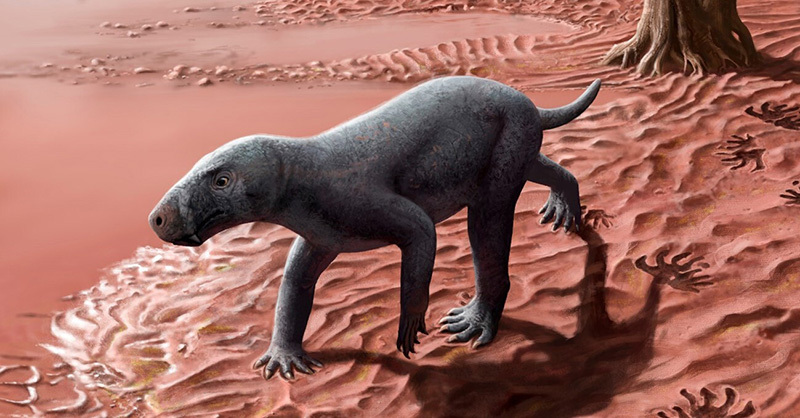Mediterranean fossil is the world’s oldest saber-toothed protomammal
December 17, 2024

Image credit: Henry Sutherland Sharpe.
NC Museum of Natural Sciences’ researcher helps describe 270-million-year-old predator
An international team of researchers from the North Carolina Museum of Natural Sciences in Raleigh and the Institut Català de Paleontologia Miquel Crusafont and Museu Balear de Ciències Naturals in Spain have described a fossil animal that lived between 270 and 280 million years ago in present-day Mallorca, a Spanish island in the Mediterranean Sea. The discovery is exceptional because it is the oldest known gorgonopsian, a type of saber-toothed predator closely related to the ancestors of mammals. The research has been published in the journal Nature Communications.
The abundant remains recovered in Mallorca belong to a small- to medium-sized animal, approximately 3 feet in length. “The large number of bones is surprising,” explains Rafel Matamales, curator of the Museu Balear de Ciències Naturals, Research Associate at the Institut Català de Paleontologia Miquel Crusafont (ICP) and first author of the article. “We have found everything from fragments of skull, vertebrae and ribs to a very well-preserved femur.”
Its location in the Balearic Islands is also unusual. Most remains of gorgonopsians prior to this discovery were discovered in very high latitudes such as in Russia or South Africa. “Finding a gorgonopsian in the Mediterranean was a huge shock,” says Christian Kammerer, co-author of the article and Research Curator of Paleontology at the North Carolina Museum of Natural Sciences. “I think there is the idea that after hundreds of years of research, European fossils are very well known, but this specimen demonstrates that there are still completely new faunas to be found in the region.”
Among the excavated fossil remains, a nearly complete leg stands out, which has allowed researchers to study how the animal moved. Unlike reptiles, that moved with their legs more spread out, gorgonopsians had their legs positioned more vertically and, therefore, moved in a way that was intermediate between reptiles and mammals. This system is more efficient for walking and especially for running.
When Mallorca Was Not an Island
During the Permian, approximately 270 million years ago, Mallorca was not an island but was part of the supercontinent Pangaea and located at an equatorial latitude similar to where countries like Congo or Guinea can be found today. The climate was monsoonal, alternating between wet and very dry seasons. The site where the fossils were found was a floodplain with temporary ponds where gorgonopsians and other fauna drank. Among the animals that cohabited in this ecosystem were moradisaurine captorhinids, an ancient group of herbivorous reptiles that included Tramuntanasaurus tiai, whose skeleton was found adjacent to that of the new gorgonopsian and which may have been part of its diet.
The discovery of a definitive paleo-equatorial gorgonopsian suggests that the therapsid ancestors of mammals first evolved in the tropics, rather than in temperate regions as previously thought. “Much remains unknown about the origin of therapsids, particular as concerns their biogeography,” says Kammerer. “The earliest synapsids, things like the sail-backed Dimetrodon, are mostly found in the paleotropics, whereas therapsids like gorgonopsians and dicynodonts are almost entirely known from higher latitudes. At some point this lineage must have moved from one place to another, but historically we have had very few localities that might fill that gap. The gorgonopsian find in Mallorca shows the importance of fieldwork outside of the ‘classic’ synapsid localities. Hopefully more work in the region will yield other therapsid fossils, which would massively improve our knowledge of their earliest history.”
###
For more information about our upcoming activities, conservation news and groundbreaking research, follow @NaturalSciences on Instagram and Facebook.

